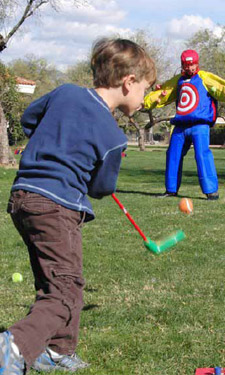 Tennis and golf are lifetime sports that have seen participation rates wane over the years. Quick- Start Tennis has rejuvenated the sport while introducing a new generation to the game of tennis. SNAG Golf is positioned to do the same for the game of golf.
Tennis and golf are lifetime sports that have seen participation rates wane over the years. Quick- Start Tennis has rejuvenated the sport while introducing a new generation to the game of tennis. SNAG Golf is positioned to do the same for the game of golf.
Golf and tennis have more in common than their early balls of stuffed leather stitched up tight. Both are sports promoting health and wellness, and both can be enjoyed into the retirement years. Physical education professionals recognize tennis and golf as games well worth learning and pursuing. Traditionally, however, there have been barriers to introducing these sports to younger generations.
With QuickStart Tennis, a scaled-down form of the game with simplified rules that uses smaller courts with lower nets, colorful, age-appropriate racquets, and brightly- colored and slower balls, children have an entry point for tennis. After all, Little Leaguers don’t start playing baseball on the same-sized diamond as the professionals, so why should tennis (and golf) be any different?
So reasoned Robert Paul Pangrazi, professor in the Department of Science and Physical Education at Arizona State University and author of several books on better ways to teach sports. His idea in developing QuickStart Tennis was to create a kid-friendly method whereby youngsters could learn in an environment of fun, while allowing participants to move to new skills and new equipment as they progress.
Now, with the backing of the U.S. Tennis Association, QuickStart Tennis has proved highly effective in getting kids turned on to the game, especially when introduced in schools and park and recreation facilities. With the courts portable enough to be set up anywhere—backyards, parking lots, and gyms—tennis is now much more accessible to kids and their families.
Finally, there is also a program designed to get children interested in the game of golf. Starting New At Golf (SNAG) G-Ball, golf’s answer to T-Ball, is being added to the activities and sports agendas of recreation departments, golf clubs, and schools in the United States and abroad. Under Dr. Pangrazi’s guidance, the SNAG G-Ball curriculum has set the standard for growing golf around the world.
Just as with QuickStart Tennis, where colorful equipment is used, SNAG’s clubs, targets, and tools are rendered in reds, blues, yellows, and greens. Whereas golf is often perceived as a difficult game to learn, SNAG takes the frustration out while infusing the learning process with a fun and intuitive way to develop the game properly and painlessly.
Like QuickStart Tennis, SNAG too is portable and can be played just about anywhere indoors or outdoors. As recreation professionals find they can set up a SNAG field anywhere, even away from their main facility, it is not surprising that a number of park and recreation agencies are adding SNAG to their programs. It’s a natural fit with communities’ focus on the outdoors and improving health and wellness.
“Parks sign up millions of children for various programs every year. Up until now, children could participate in every sport except golf,” says Jimmy O’Connor, NRPA’s senior manager of corporate grants. “When QuickStart Tennis was introduced, tennis really took off.”
“SNAG can do the same for golf,” O’Connor continues. “For the first time, golf can be offered to children and there is a huge demand for it. When NRPA announced $180,000 would be available through SNAG G-Ball grants, more than 200 agencies contacted us, but we only had funding for 15 grants. We hope to increase that.”
Just as QuickStart Tennis has boosted the tennis industry by making it more accessible to kids, SNAG has the potential to turn golf around. With SNAG G-Ball designed for children 5-8 years of age and the traditional SNAG program serving individuals 9 years and older (including adults and seniors), there is an entry point for anyone interested in learning the game of golf.
Every element that SNAGsters (as SNAG calls its new golfers) need to learn the game is included in the SNAG system. These include a modified score card with simplified rules that impose no penalties for misses, Launcher and Roller clubs, SNAG Balls, and a Flagsticky. The Launcher does the jobs of the driver and iron while the Roller serves as the putter.
Essentially, SNAGsters hit the ball to a target or Flagsticky where hook-and-loop fabric causes the balls to stick on impact. Other SNAG training tools include the Bullseye Target to hone pitching skills, the Rollerama to help in chipping and putting, large cup-like tees, and the noise-producing SNAGazoo designed to promote proper pitching.
“We are excited to bring golf into the youth team sports arena with our G-Ball program, and we thank NRPA for bringing this program to life in America’s local communities,” says Terry Anton, president of SNAG Golf. “SNAG also offers easy-to-understand training on how to become a SNAG instructor and set up a SNAG event for families.”

